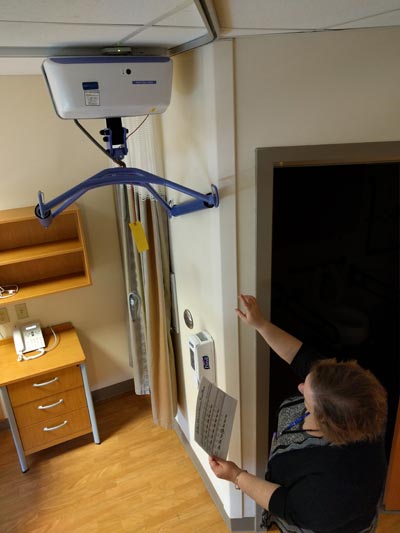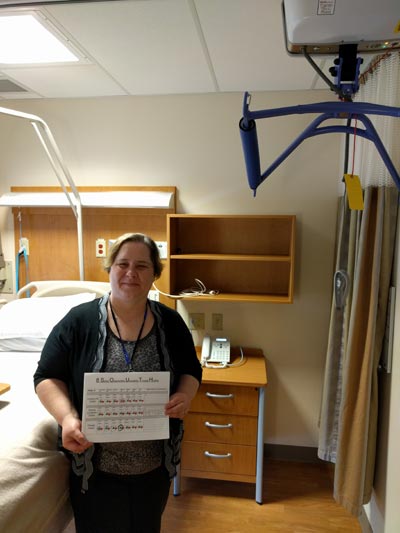
Elaine Murphy, manager, 8 South, Toronto Rehab, checks to make sure a patient lift is charging properly. (Photo: UHN)
Some people cringe when they hear the word audit. This is not the case for the staff on 8 South, the musculoskeletal unit at Toronto Rehab.
"We use safety audits as a way to reinforce and supplement education, not to point fingers," says Elaine Murphy, Manager, 8 South.
The team introduced weekly safety audits when it became apparent education alone wasn't enough to make sure everyone remembered to return the ceiling patient lifts to the docking stations to charge after use.
Did you know?
When a rechargeable lift battery isn’t charged for three days the liquid inside it hardens and must be replaced, at a cost of approximately $50.
UHN recycled 4.1 metric tons of batteries in 2015 – about as much as an adult male hippopotamus!
If the lift batteries are dead when staff need to transfer a patient in or out of a bed, it creates a safety risk for everyone involved. Staff members could injure themselves lifting too much weight, and patients are more likely to sustain a fall.
The audits work like this: once per week, an assigned member of the inter-professional team checks every patient room to make sure the ceiling lift is charging and the sharps container for needles and other sharp objects is empty. The staff member then notes whether the audit was a "thumbs up" or "thumbs down" and presents their findings to the broader team at the morning huddle.
When they find a problem, they immediately inform the person assigned to the room and have them correct it.

The team on 8 South works together to ensure the safety of patients through regular audits. The teamwork is one of the best aspects of the process, says Elaine, pictured here holding an auditing checklist used by staff. (Photo: UHN)
Having every member of the team take a turn conducting an audit is a great way to make sure safety procedures are properly followed, while also reinforcing the standards periodically so that all staff are thoroughly educated.
"We find this system works because it involves all members of the team - nurses, social workers, therapy staff, unit aids and housekeepers," says Elaine. "Actually going and looking regularly reinforces our standards for the person conducting the audits, and by including everyone, we send the message that ensuring patient safety is everyone's responsibility.
HRO Principle: Sensitivity to Operations
Employees in high reliability organizations are constantly on the lookout for small indicators of potential problems in order to address them before they escalate.
Regular audits provide an opportunity to verify equipment is ready when needed, which protects staff and patients.
"It becomes automatic to take a quick look around when you walk into a room."
It also helps that the audits aren't too onerous.
"There was a bit of hesitation at first because some of us thought that we'd be responsible for fixing any problems we found, or we felt uncomfortable talking to our colleagues about problems," says Laverna Reimer, Social Worker, 8 South.
"We all see the value now, and it only takes a couple of minutes."
